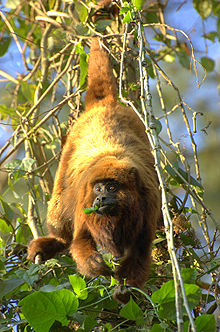Southern brown howler
| Southern brown howler | |
|---|---|

| |
| Alouatta guariba clamitans | |
| Scientific classification | |
| Domain: | Eukaryota |
| Kingdom: | Animalia |
| Phylum: | Chordata |
| Class: | Mammalia |
| Order: | Primates |
| Suborder: | Haplorhini |
| Infraorder: | Simiiformes |
| Family: | Atelidae |
| Genus: | Alouatta |
| Species: | |
| Subspecies: | A. g. clamitans
|
| Trinomial name | |
| Alouatta guariba clamitans Cabrera, 1940
| |
The southern brown howler (Alouatta guariba clamitans) is a monkey subspecies of brown howler native to southeastern Brazil (Minas Gerais to Rio Grande do Sul) and far northeastern Argentina (Misiones).[1] Gregorin, 2006, considered the southern brown howler to be a separate species, Alouatta clamitans, but this has not been universally accepted.[2][3][4]
Distribution and habitat[edit]

The southern brown howler is found in the Atlantic forests of eastern Brazil where it occurs in the states of Espírito Santo, Rio de Janeiro, Minas Gerais, São Paulo, Paraná, Santa Catarina and Rio Grande do Sul. Its range extends southwards as far as the Camaquã River and eastward to Misiones Province in Argentina. Its northern extent is unclear, but may be the Doce River or the Jequitinhonha River. Habitats include lowland, sub-montane and montane forests, and it is tolerant of disturbed habitats and human encroachment.[1]
Ecology[edit]
Howlers move around in small troops, consisting of a dominant male, several females and a number of juveniles. The monkeys are so called because of the loud calls made by males, more roar than howl, which can be heard a mile (1.5 km) or more away, mostly at dawn and dusk. The throats of males have enlarged vocal sacs and large tracheal cartilages which act as resonators to amplify the sounds. The diet of these monkeys consists mostly of leaves, supplemented by flowers and fruit, and these foods being plentiful in the rainforest, the territories defended by the troops are small. Rival troops howl at each other but territorial disputes are mostly settled vocally, without the monkeys needing to meet face to face.[5]
In the Araucaria pine forests of southern Brazil, the chief predators of these monkeys are ocelots (Leopardus pardalis), cougars (Puma concolor), and jaguars (Panthera onca), as well as the larger birds of prey.[6]
Status[edit]
The International Union for Conservation of Nature has assessed this monkey's conservation status as being vulnerable. This is partly because of the monkey's susceptibility to yellow fever; during the period 2007 to 2009, an outbreak of yellow fever killed large numbers of howlers in the Misiones Province in Argentina, and the State of Rio Grande do Sul in Brazil.[1] The animal has a wide range and is present in a number of protected areas, but the rainforest in which it lives is being cleared for cattle ranching and agriculture, resulting in fragmentation of the forest. The subpopulations in these fragments are likely to suffer from inbreeding. They are also impacted by urbanisation and are hunted for food.[1]
References[edit]
- ^ a b c d e Mendes, S. L.; Rylands, A. B.; Kierulff, M. C. M. & de Oliveira, M. M. (2020). "Alouatta guariba ssp. clamitans". IUCN Red List of Threatened Species. 2020: e.T39918A17979180. Retrieved 3 March 2021.
- ^ Printes, Rodrigo C.; et al. (December 2010). "The Urban Monkeys Program: A Survey of Alouatta clamitans in the South of Porto Alegre and its Influence on Land use Policy between 1997 and 2007". Primate Conservation. 2010 (25): 11–19. doi:10.1896/052.025.0103. S2CID 86045499. Retrieved 2020-04-18.
- ^ "Alouatta guariba clamitans". ITIS. Retrieved 2020-04-18.
- ^ "Alouatta". American Society of Mammalogists. Retrieved 2020-04-18.
- ^ Kricher, John (2017). The New Neotropical Companion. Princeton University Press. pp. 326–327. ISBN 978-0-691-11525-2.
- ^ Miranda, João M. D.; Bernardi, Itiberê P.; Abreu, Kauê C. & Passos, Fernando C. (2005). "Predation on Alouatta guariba clamitans Cabrera (Primates, Atelidae) by Leopardus pardalis (Linnaeus) (Carnivora, Felidae)". Revista Brasileira de Zoologia. 22 (3): 793–795. doi:10.1590/S0101-81752005000300043.
- IUCN Red List vulnerable species
- Howler monkeys
- Mammals of Argentina
- Primates of Brazil
- Fauna of the Atlantic Forest
- Environment of Minas Gerais
- Environment of Paraná (state)
- Environment of Rio Grande do Sul
- Environment of Santa Catarina (state)
- Environment of São Paulo (state)
- Misiones Province
- Taxa named by Ángel Cabrera
- Mammals described in 1940

